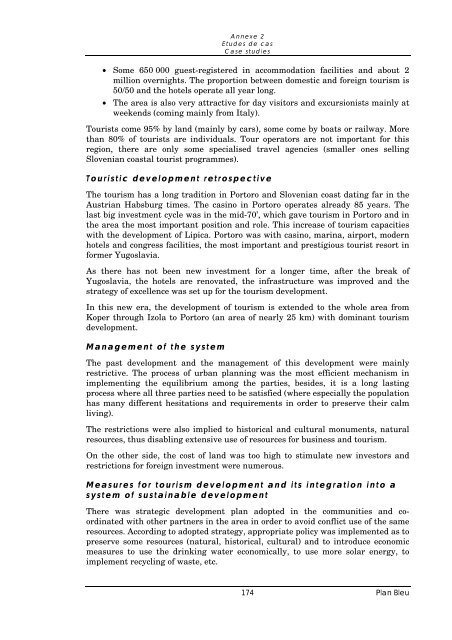MEDITERRANEAN ACTION PLAN
MEDITERRANEAN ACTION PLAN
MEDITERRANEAN ACTION PLAN
Create successful ePaper yourself
Turn your PDF publications into a flip-book with our unique Google optimized e-Paper software.
Annexe 2<br />
Etudes de cas<br />
Case studies<br />
• Some 650 000 guest-registered in accommodation facilities and about 2<br />
million overnights. The proportion between domestic and foreign tourism is<br />
50/50 and the hotels operate all year long.<br />
• The area is also very attractive for day visitors and excursionists mainly at<br />
weekends (coming mainly from Italy).<br />
Tourists come 95% by land (mainly by cars), some come by boats or railway. More<br />
than 80% of tourists are individuals. Tour operators are not important for this<br />
region, there are only some specialised travel agencies (smaller ones selling<br />
Slovenian coastal tourist programmes).<br />
Touristic development retrospective<br />
The tourism has a long tradition in Portoro and Slovenian coast dating far in the<br />
Austrian Habsburg times. The casino in Portoro operates already 85 years. The<br />
last big investment cycle was in the mid-70’, which gave tourism in Portoro and in<br />
the area the most important position and role. This increase of tourism capacities<br />
with the development of Lipica. Portoro was with casino, marina, airport, modern<br />
hotels and congress facilities, the most important and prestigious tourist resort in<br />
former Yugoslavia.<br />
As there has not been new investment for a longer time, after the break of<br />
Yugoslavia, the hotels are renovated, the infrastructure was improved and the<br />
strategy of excellence was set up for the tourism development.<br />
In this new era, the development of tourism is extended to the whole area from<br />
Koper through Izola to Portoro (an area of nearly 25 km) with dominant tourism<br />
development.<br />
Management of the system<br />
The past development and the management of this development were mainly<br />
restrictive. The process of urban planning was the most efficient mechanism in<br />
implementing the equilibrium among the parties, besides, it is a long lasting<br />
process where all three parties need to be satisfied (where especially the population<br />
has many different hesitations and requirements in order to preserve their calm<br />
living).<br />
The restrictions were also implied to historical and cultural monuments, natural<br />
resources, thus disabling extensive use of resources for business and tourism.<br />
On the other side, the cost of land was too high to stimulate new investors and<br />
restrictions for foreign investment were numerous.<br />
Measures for tourism development and its integration into a<br />
system of sustainable development<br />
There was strategic development plan adopted in the communities and coordinated<br />
with other partners in the area in order to avoid conflict use of the same<br />
resources. According to adopted strategy, appropriate policy was implemented as to<br />
preserve some resources (natural, historical, cultural) and to introduce economic<br />
measures to use the drinking water economically, to use more solar energy, to<br />
implement recycling of waste, etc.<br />
174<br />
Plan Bleu
















